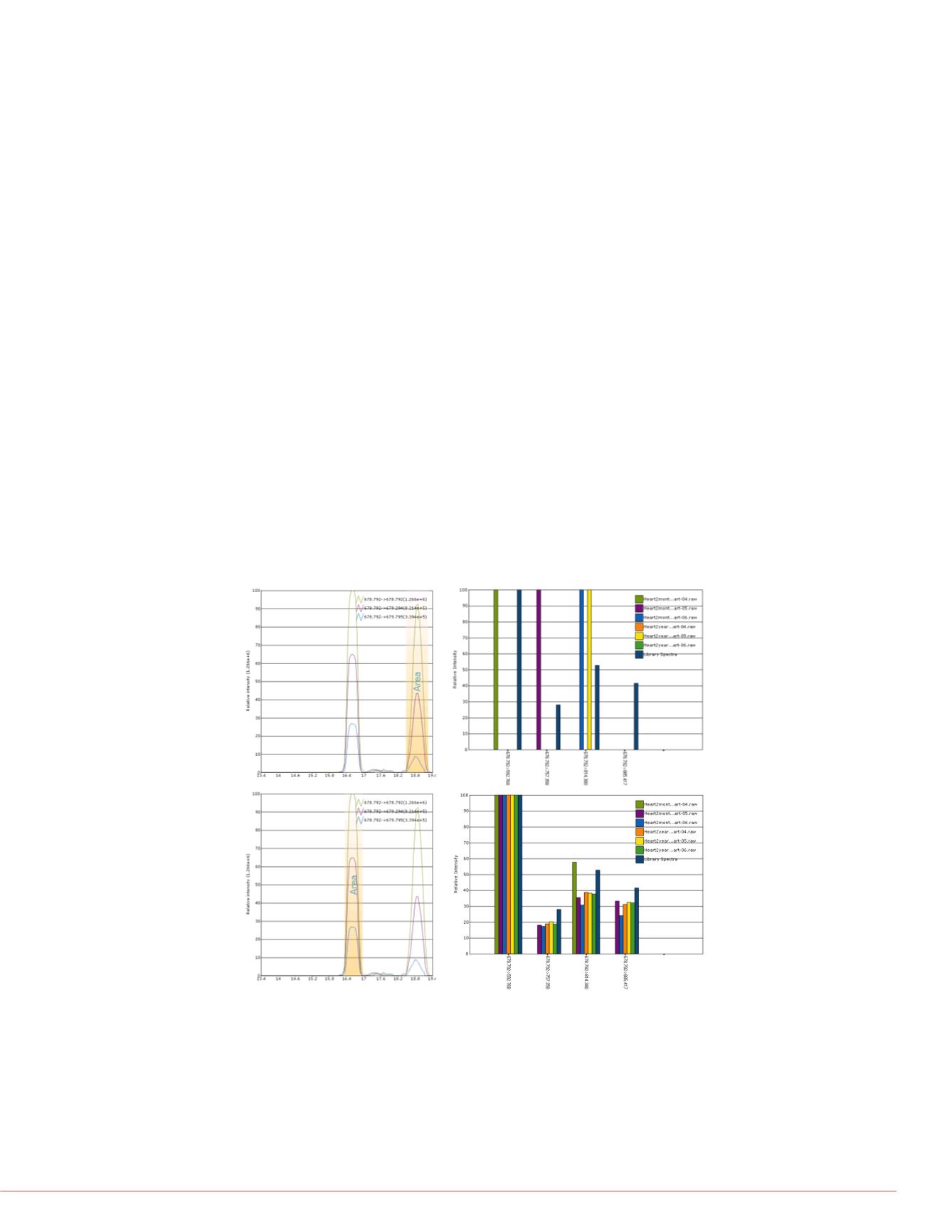

5
Thermo Scientific Poster Note
•
PN-64144-ASMS-EN-0614S
All trademarks are the property of Thermo Fi
encourage use of these products in any man
FIGURE 4. Advantage of pSMART. Using a hybrid of DDA and DIA allows for
confirmation of MS1 quantification. A and C are the MS1 peaks for two different
peptides. B and D are the composite MS/MS spectra for the top 4 transition ions
for the highlighted peaks (A and C, respectively). Given that these two peaks are
relatively close in a 3 hour gradient run, it would be difficult to confidently
choose the correct MS1peak for label-free quantitation without added MS/MS data
provided by pSMART. The highlighted peak in C is the correct precursor for
peptide GDP[Hydroxyl]GEAGPQGDQGR, confirmed in D.
The primary challenge to global pr
Reliance on spectral libraries not
acquisition data processing, but al
decrease manual peak integration
isolation windows result in greater
traces that introduce errors in aut
MS and 5 Da DIA data, each acqu
DIA spectra to reduce target ion si
manual post-acquisition processin
DDA events (
e.g.
narrow precurso
spectrum needed for confident se
window can be increased with lon
than previously reported for stand
the robustness of automated data
abundant peptides that can be glo
value. The results of the ROC an
targeted, high-throughput method
This workflow has several advantages
vis a vis
DDA or DIA alone.
Narrower acquisition windows result in greater sensitivity and selectivity, since the
precursor isolation window is inversely proportional to qualitative and quantitative
performance.
Increased selectivity results in lower FDR.
Using a hybrid of DDA and DIA allows for confirmation of MS1 quantification due to
the many MS/MS fragmentation spectra that are acquired within the narrow windows.
This workflow is only possible with the increased speed and higher resolution
provided by the Fusion MS and other High Resolution Accurate Mass (HR/AM)
Orbitrap instruments.
The benefits of the pSMART method listed above enable robust complex sample
characterization compared to DDA and standard DIA methods. Decoupling
quantitative from qualitative data acquisition leverages the high-resolution capabilities
and high charge densities of the Orbitrap mass spectrometer. The combination of data
acquisition methods facilitates confident targeted peptide determination and
quantification. Figure 4 shows an example of two peaks that are chromatographically
resolved but have similar precursor m/z values and isotopic distribution profiles. The
HR/AM MS coupled to a series of smaller DIA mass window acquisitions allows for
increased confidence in the MS1 quantification. Spectral matching of the specific 5 Da
DIA window containing the precursor collected under each peak, clearly identifies the
retention time at 16.4 minutes
versus
18.8 minutes, based on the presence and
correct product ion distribution of the spectral library entry,
es discovered with pSMART.
easured using the MS1
tide ID using MS/MS
relative areas for young
QEQEYVQAVK
PTFSSLNLR
LVPFVVQLSGHLAQETER
lus] - EFSITDVVPYPISLR
A
B
D
C
Conclusion
We have created a high qu
5900 protein/19,900 peptid
Using the pSMART workflo
in label-free discovery exp
each quantified precursor i
The pSMART workflow co
increased protein assignm
DIA methods
1-3
.
References
1. Prakash, A., Peterman, S.,
Byram, G., Krastins, B., Va
processing strategies with i
Proteome Research (subm
2. Egertson, J.D., Kuehn, A.,
Ting, Y. S.,Canterbury, J. D
C., MacCoss, M. J., Multipl
acquisition. Nature Method
3. Gillet, L.C., Navarro, P., Ta
Aebersold, R., Targeted da
data-independent acquisiti
proteome analysis. Molecu



















